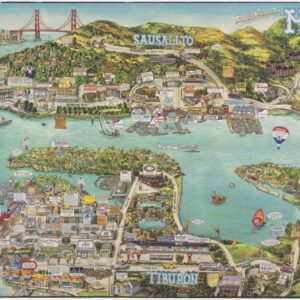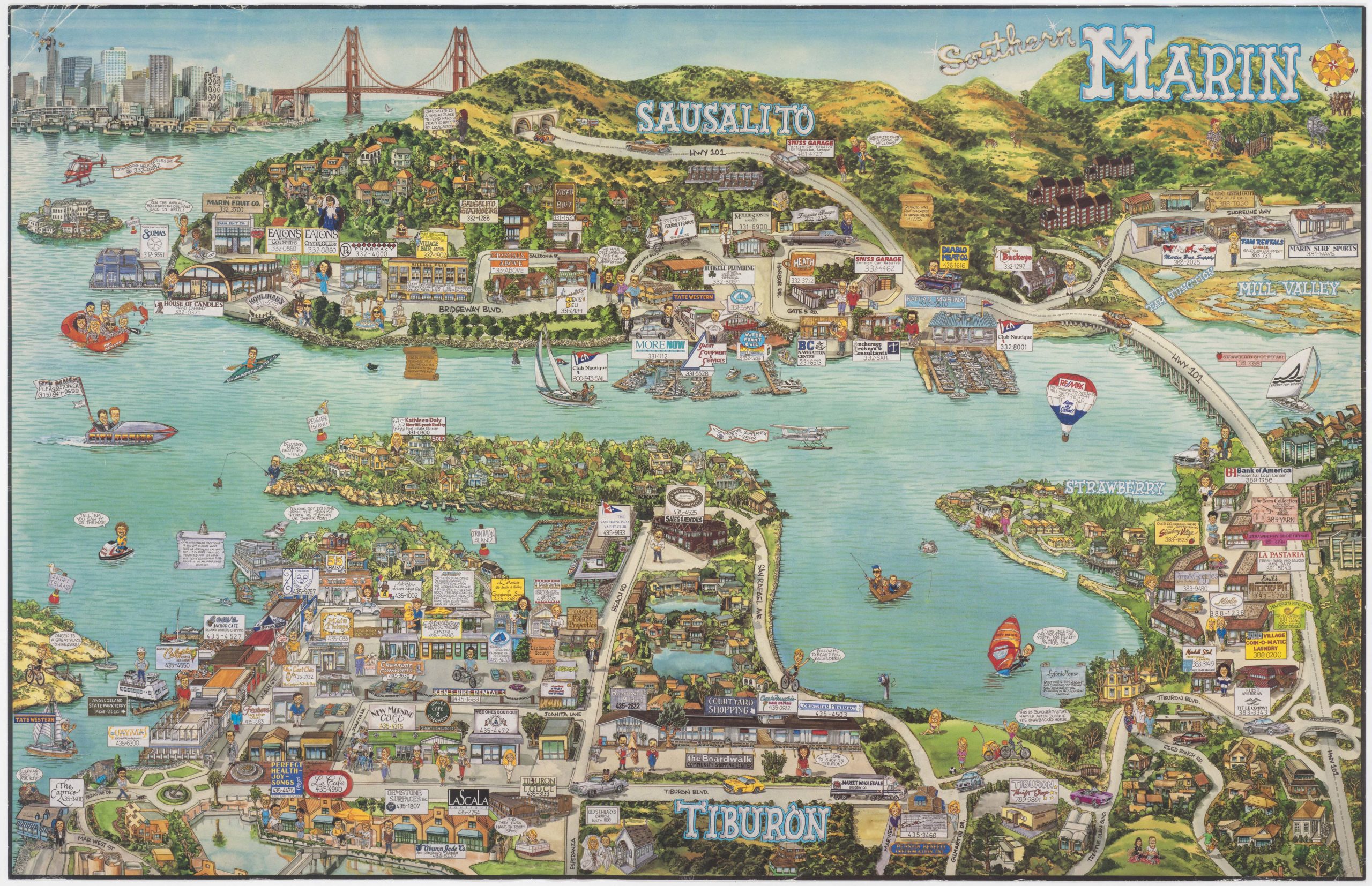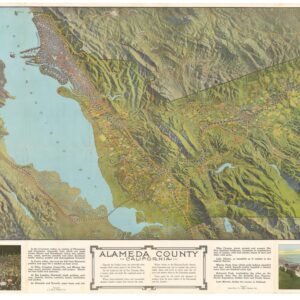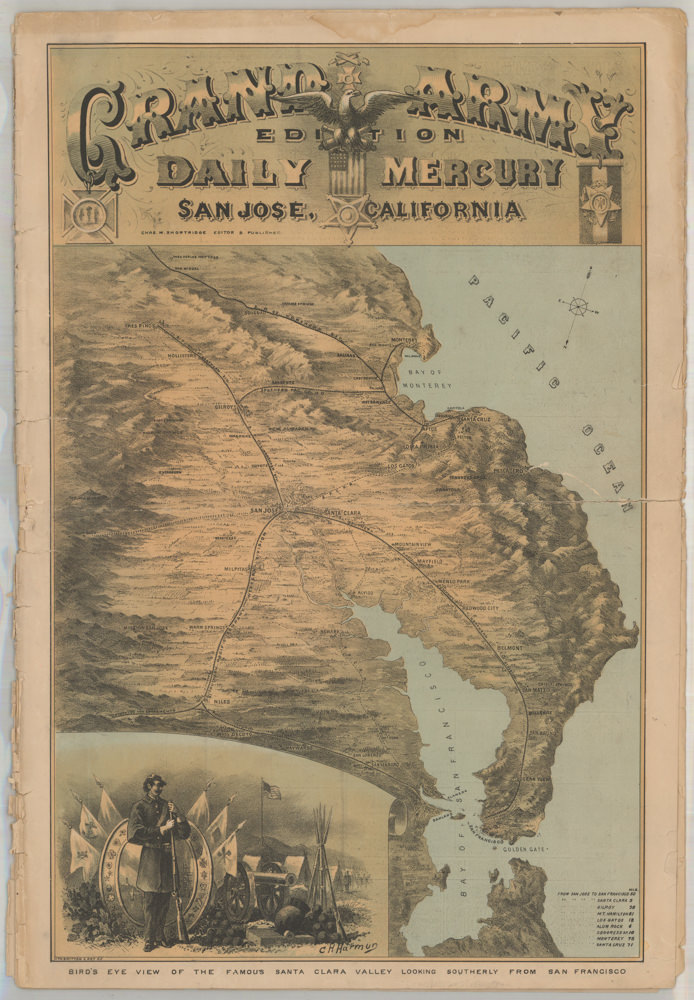William Henry Jackson’s panoramic photochrom of Berkeley and the Bay Area at the dawn of the 20th century.
The Golden Gate from Berkeley Heights
$1,800
1 in stock
Description
This panoramic photograph of Berkeley and the Bay Area is among the earliest color photographs of an urban vista produced in the United States. The shots compiling this stunning turn-of-the-century view were originally taken by one of the most well-known photographers to come out of America, William Henry Jackson. Jackson is known as the photographer who introduced the photochrom process to America, and using this technique, he produced some of the most iconic early 20th-century photographs of the American West.
Jackson sets the view from a vantage point in the Berkeley Hills, presumably somewhere near the location of the University of California Botanical Garden. In the foreground, we see the university’s main buildings. Despite the photograph being over 120 years old, anyone familiar with the grounds will quickly recognize some of the more historic structures on UC Berkeley’s campus.
When the university initially moved from Oakland to Berkeley in 1873, the new campus consisted more or less of two large buildings: North Hall and South Hall, both of which are visible in this image. While North Hall housed the College of Letters, South Hall housed the College of Sciences and the University’s library holdings, which were rapidly growing in the late 19th century. A monumental edifice was built to accommodate the expanding library and a newly acquired art collection. Easily recognizable by its cylindrical form and characteristic verdigris copper roof, Bacon Hall is visible at the forefront of the photograph. Throughout the early years of the university’s history, this iconic building served as the university’s main library, but by 1908 the holdings had grown so dramatically that a decentralization plan was necessary.
Jackson’s view of the campus and town of Berkeley soon became so popular among alumni and visitors that the panoramic color photograph was repurposed into a smaller format as an official UC Berkeley postcard. From the campus down to the marina, we note the large boulevards of Hearst Avenue and University Avenue standing out in the landscape. These still constitute some of the main traffic arteries in Berkeley today. In the distance, adorning the Bay’s blue waters, we see the profiles of Yerba Buena, Alcatraz, and Angel Island. Behind them, one senses the Golden Gate itself, created by the great promontories of San Francisco and Marin and, at this stage, still unadorned with its iconic bridge. To the south, on the far left side of the photograph, Oakland stands out from the surrounding built-up area due to its large railway piers stretching into the Bay.
All in all, an absolutely stunning color view of Berkeley and the Bay Area at the turn of the 20th century.
Context is everything: William Henry Jackson and the Photochrom Process
We have already noted how William Henry Jackson was among the most important American photographers of the early 20th century, especially when it came to documenting the American West. Jackson’s fame is partly tied to his employer, the Detroit Photographic Company, for whom he was employed as a photographer from 1897 forward.
The Detroit Photographic Company had acquired the American license for an entirely new photographic technique a few years before, which saw the introduction of the first color photographs for mass consumption. The method was developed during the 1880s by Hans Jakob Schmidt and was known throughout Europe as the photochrom process. Schmidt’s technique produced color photographs by transferring original black and white negatives to a lithographic stone and then printing these composite photographs in color. Modern viewers often wonder why these early photographs’ chromatic hues seem almost unreal: it is because they are.
In 1898, Congress passed the so-called Private Mailing Card Act, which allowed printing companies to produce postcards for private use among citizens. The Act not only prompted the commercial creation of early postcards but also ensured that these could be sent at a flat rate of a penny per card. Quickly printers followed suit so that the standard price for the postcard would be the same as the postage. The act saw a range of new printers shoot up all over America and, in effect, launched the modern postcard industry. Soon after the realistic photochroms were introduced, they became some of the most popular printed products, partly because they introduced an entirely new means for traveling family or friends to relay some of their impressions to those back home.
In the United States, Schmidt’s procedure had been licensed out to the Detroit Photographic Company, where Jackson worked as a photographer. Some years later, during the peak of the postcard craze, Jackson was made plant manager (1903). It is believed that the Detroit Photographic Company was producing as many as seven million postcards per year. Most of these were smaller and simpler images, made explicitly for use as postcards. Such abundance was sadly not afforded large and early photochrom vistas such as this, which were produced in far smaller numbers and only catered to a very dedicated and specific audience, making them exceedingly rare a century later.
Cartographer(s):
The Detroit Photographic Company was a photographic publishing firm established in the late 1890s. Its founders, William Livingstone, Jr., and Edwin Husher, bought the rights to employ the Swiss “Photochrom” process for converting black-and-white photographs into color images and printing them by photolithography. The firm was able to employ the process to mass-produce color postcards, prints, and albums.
William Henry JacksonWilliam Henry Jackson (1843-1942) was an American photographer, Civil War veteran, painter, and explorer who has become particularly famous for his early photographs of the American West. Following his participation as a Union soldier in the Civil War, Jackson won a commission from the Union Pacific Railroad to document the extraordinary scenery along the various routes for promotional purposes. This project led him to explore the West and initiated a life-long fascination with this frontier region of America.
Jackson’s photographs of the Union Railroad landscapes were of incredible quality and soon attracted the attention of other Western pioneers. Consequently, Ferdinand Vanderveer Hayden him to join his team of geologists on their expedition to the Yellowstone River. In addition to being one of America’s most important early photographers, Jackson was also the great-nephew of Sam Wilson, progenitor of the United States’ national symbol, Uncle Sam.
Condition Description
Very good. Some wear at bottom-right corner.
References







![The Original Silicon Valley Map & Calendar [1994]](https://neatlinemaps.com/wp-content/uploads/2021/06/NL-00909_Thumbnail-300x300.jpg)
![The Original Silicon Valley Map & Calendar [1994]](https://neatlinemaps.com/wp-content/uploads/2021/06/NL-00909_Thumbnail.jpg)